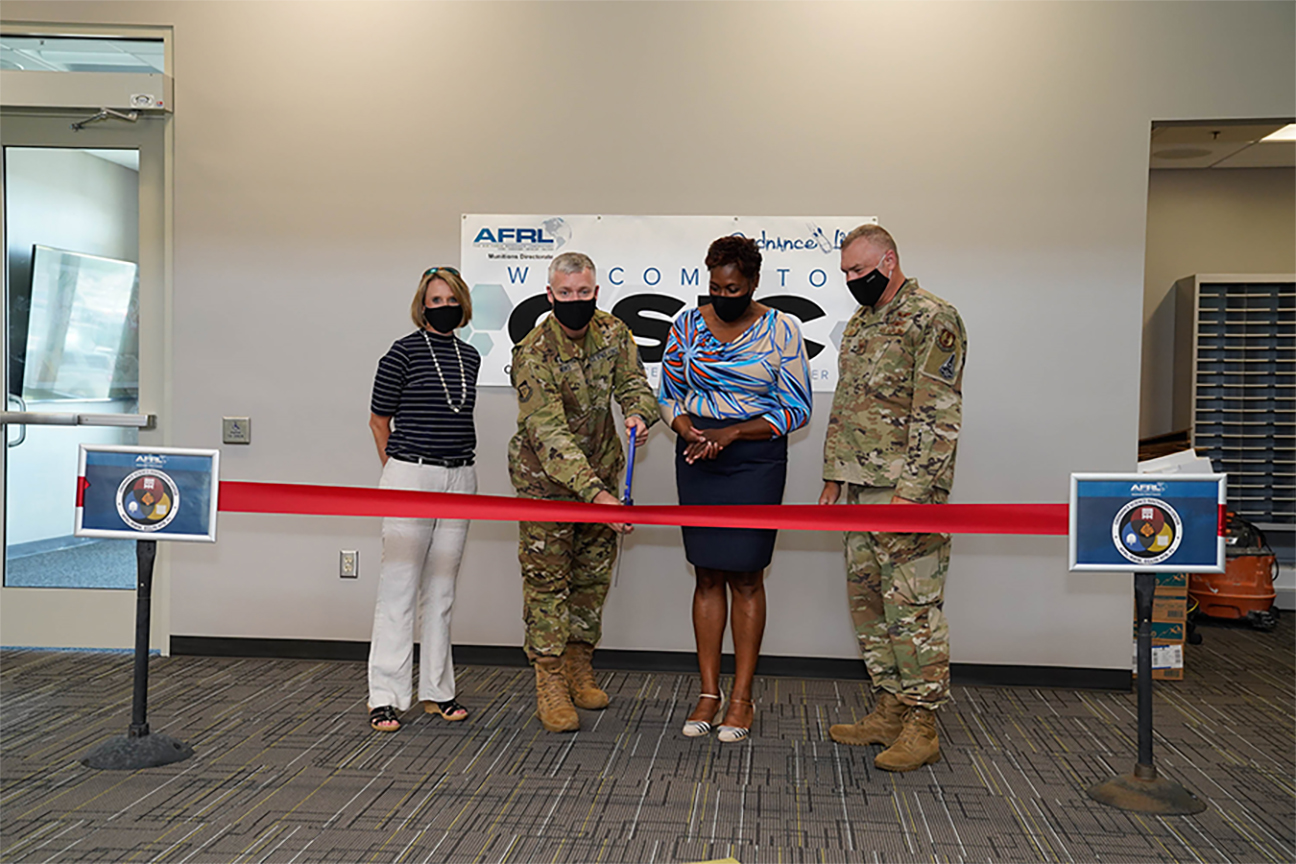AFRL Munitions Directorate opens new collaborative facilities for faster technology development
EGLIN AIR FORCE BASE, Fla. (AFRL) – The Air Force Research Laboratory Munitions Directorate recently opened two new jointly constructed facilities here, designed to serve as adaptable and collaborative workspace environments. These facilities will encourage rapid, cross-disciplinary interactions and cultivate an inspiring, creative, and innovative culture between ordnance science researchers and modeling and simulation software developers – two groups that typically do not mingle.
The Ordnance Science Innovation Center building is a critical collaborative facility approved under Advanced Munition Technology Complex Military Construction – a $98 million Military Construction funded effort that is providing state of the art capabilities to develop explosive material for the U.S. Air Force. Located directly next to OSIC, the Applied Computational Engineering and Sciences facility is an advanced computing facility that provides the Air Force Research Laboratory a predictive capability for weapon development and assessment. The two facilities are a result of a partnership between the Army Corp of Engineers, Eglin Civil Engineering, and AFRL.
The larger of the two buildings, OSIC was designed from the ground up to be flexible with a variety of “break out” rooms and shared work spaces. A broad central collaboration space is flanked by two office wings with work areas for more than 60 people. With a spacious, open design in mind, OSIC lends itself to collaborative events and seminars, the result of which will be integrated technology innovations.
OSIC’s smaller counterpart, ACES, is equally impressive. The core of the facility is a powerful software design laboratory that includes offices for more than 50 software development experts. Together, these buildings surpass the limitation of separating researchers focused on solutions for ordnance fuzing, warheads, and explosives. The ACES facility was intentionally designed with collaboration in mind and includes team work rooms that will facilitate cross-ordnance integration.
Col. Anthony Meeks, director of AFRL’s Munitions Directorate, has high expectations for OSIC and ACES. He proudly describes the facilities as “…the mashup of multiple areas of expertise, multiple areas of passion for ordnance sciences.” Meeks goes on to say that working together, the OSIC and ACES facilities will provide the U.S. Air Force with “transformational ideas that are rapidly developed, coupling the best of science and technology, and achieving what the Air and Space Force needs for us to do.”
Though the construction of the facilities fell under one contract, separate funding streams enabled bidders to capitalize on bulk purchases, a common staging area, and a phased construction requiring smaller functional work crews. Because of the shared contract and multifaceted funding, development was notably cost efficient and occurred on a far more rapid timeline.
Ordnance Deputy Division Chief, Timothy Tobik, references the strategic importance of these facilities, “The DAF Science and Technology Strategy calls to develop and deliver transformational strategic capabilities. OSIC and ACES create the essential environment to pursue multidisciplinary solutions to deliver strategic capabilities to the warfighter.”
Future air and space solutions will require an integrated approach to deliver warfighter capability, and the collaborative nature of OSIC and ACES accomplishes just that. The modern and deliberately designed buildings provide cross-discipline munition technologists the space to collaborate in the advancement of weapons and maximize interactions for cognitive diversity in a rich and innovative environment.
The researchers in the OSIC and ACES will develop the next generation’s weapons starting from digital concepts, conducting simulation analysis for design iterations, building sub-scale and full scale prototypes, and executing complex testing to verify functionality.
Tobik looks forward to a bright future for OSIC and ACES, and said, “With the opening of these two facilities, AFRL researchers will accelerate the pace of discovery, set the course for the ordnance digital engineering landscape, and innovate nonconventional solutions to deliver capabilities to our Air and Space force.”

AFRL Munitions Directorate Commander, Col. W. Tony Meeks cuts the ceremonial ribbon for the new Ordnance Science Innovation Center on Eglin AFB, Fla. He is flanked on the left by Integration and Operations Division Chief, Jaime Pinto, and to the right by Ordnance Division Chief, Segrid Harris, followed by former Director, Col Garry Haase. (U.S. Air Force photo/John Leake)
